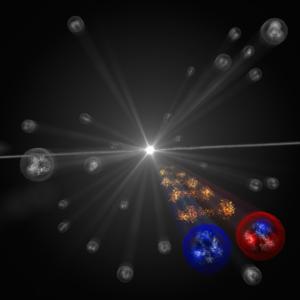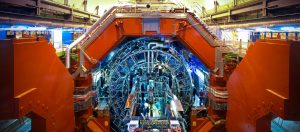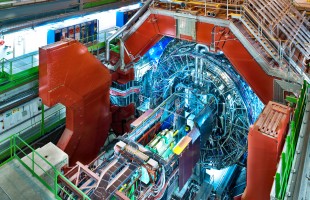Researchers of the ALICE experiment at CERN have found a new way to test the theory of the strong nuclear force. In Nature they will publish measurements of proton collisions in the LHC accelerator this week, where that force is directly visible.
During the collisions the incidental occurrence of so-called omega particles containing three so-called strange-quarks is investigated. The movement after the collision of these exotic omega’s near protons tells something about their mutual forces. Calculations of such interactions are often extremely difficult, and more difficult the more types of quarks are involved.
Basic forces
The strong nuclear force is one of the four known basic forces in nature. It is the force that holds protons and neutrons together in an atomic nucleus, despite the electrical repulsion of the positively charged protons. The same nuclear force also binds the three quarks in the protons and neutrons.

In ordinary matter these are combinations of up and down-quarks, but in collision experiments with a lot of energy sometimes combinations of heavier quarks, such as strange and charm, also occur. The omega particle is the heaviest of the so-called hyperons, particles with one or more strange quarks.
Unstable particle
With a particle of three strange-quarks, the calculation of the strong nuclear force is just right. Measurements of omega particles, to test the calculations, however, are very difficult in practice. Omega particles are too unstable to form bundles for collision experiments, as is the case with protons at CERN.
In the experiments, the gigantic ALICE detector was used to look especially at omega particles that are created in the Large Hadron Collider when protons collide. The energy of the collisions causes them to move a few centimeters before they fall apart. But that turns out to be enough to accurately measure their behavior in the vicinity of a proton, says Marco van Leeuwen of the Nikhef group that contributes to ALICE.
The ALICE detector is mainly built to study the behavior of colliding heavy atomic nuclei such as gold. Bundles of heavy atomic nuclei are usually available a few weeks a year, in between the proton experiments. The so-called quark-gluon plasma that is created during such nuclear collisions must have existed shortly after the big bang.
Neutron stars
The Nikhef group at ALICE has not been directly involved in the current analysis, but Van Leeuwen says to be proud of it. Beautiful work that rightly attracts attention. However, one of the main authors Bernard Hohlweger will join Nikhef’s ALICE group as a postdoc next January. Hohlweger previously obtained his PhD on the now published research at the Technical University of Munich.

The new results are also being observed with interest by astrophysicists working on so-called neutron stars. These are extremely compact objects, remnants of collapsed stars, of a few solar masses heavy within a sphere of about ten kilometers. With gravitational wave detectors, collisions of such neutron stars are regularly observed, another research field of Nikhef.
The strong nuclear force plays an important role in the question what neutron stars consist of. According to some models, under a shell of neutrons there is a super-compact mass of quarks that behave as particles (hadrons) in triplets. Because of the temperature and pressure, these could not only be ordinary quarks, but also heavier species such as strange-quarks.
